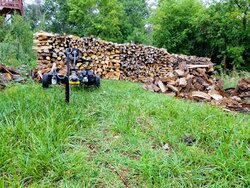My first decent stash for first year of burning. I posted it in another thread. Surprisingly a lot of it is about 18-22% on the end or side of the split
VCS
taking readings on the end is really not worth it. The readings it gives you are way off. Just go from the center of a frash split with the grain . I take an average split for the stack and use that for a guide for that wood. Last time i checked my stacks were july 4th. Next check will be mid September. That will give me a better idea if where i am.
I am doing an experment on different ways to season wood and i will be sharing my results with you guys when it is complete.
Were getting so close to burning season i cant wait for the cool down
Last edited:



